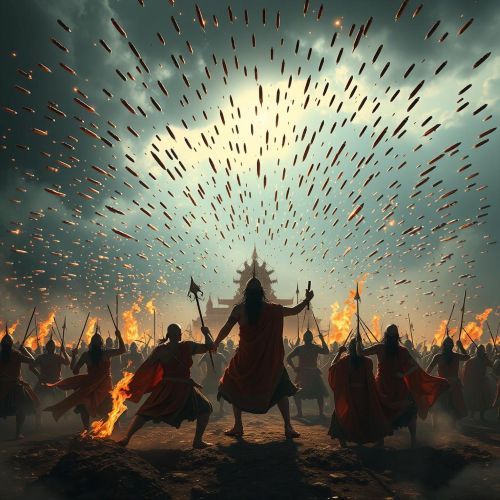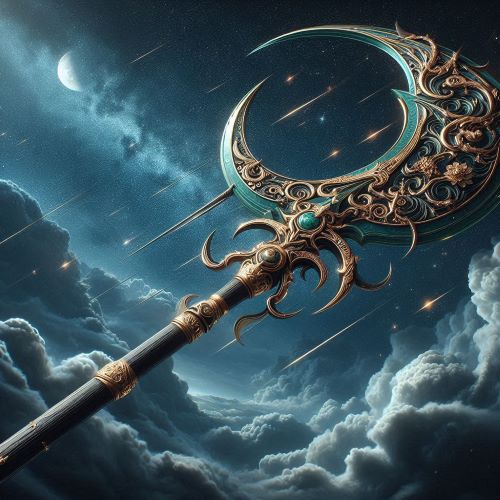Brahmashirsha Astra : The Devastating Weapon
Brahmashirsha Astra
Introduction
The Brahmashirsha Astra holds a unique and terrifying place in Hindu mythology as one of the most powerful celestial weapons ever conceived. Often considered the ultimate evolution of the Brahmastra, this divine weapon was believed to possess the strength to annihilate not only worlds but the very fabric of existence itself. Mentioned prominently in the Mahabharata and other ancient scriptures, the Brahmashirsha Astra was not merely a weapon of war—it symbolized divine justice, moral responsibility, and the immense spiritual burden of wielding absolute power. As a creation of Lord Brahma, the god of creation, it represented the paradox of destruction emerging from creation, emphasizing the cyclical nature of life and cosmic balance in Hindu philosophy.
Origins
The origins of the Brahmashirsha Astra trace back to Lord Brahma, one of the Trimurti, who embodies creation in Hindu cosmology. The term Brahmashirsha translates to “Head of Brahma,” referring to the weapon’s signature depiction of the four heads of Brahma at its tip. According to ancient texts, it was forged as a more advanced and fearsome version of the Brahmastra, designed to uphold dharma (righteousness) when the universe faced threats that could not be countered by ordinary means.
Unlike other astras, the Brahmashirsha Astra could not be wielded through physical strength but required mastery of sacred mantras and divine concentration. The wielder needed to undergo severe penance and spiritual discipline under the guidance of a guru, proving themselves worthy of such knowledge. The weapon itself embodied the dual aspects of creation and destruction—its energy stemming from the same cosmic principles that govern existence. The Mahabharata and Puranas describe the Brahmashirsha Astra as capable of returning matter to its primordial state, essentially reversing creation itself.
Think you know your myths and legends? Dive into the world of ancient stories and test your knowledge with our engaging quizzes on Mythlok!
Powers
The Brahmashirsha Astra was described as four times more powerful than the Brahmastra, making it a weapon beyond comprehension. When invoked, it unleashed unimaginable destruction—setting the skies ablaze, causing earthquakes, and drying up rivers. The air would become thick with fire and smoke, while thunder and lightning would shatter the heavens. The devastation was so absolute that no form of life could survive within its reach. Ancient scriptures mention that the area struck by the weapon would remain barren for fifty Brahma years, a timespan equivalent to over 155 trillion human years, symbolizing an eternity of desolation.
Yet, the Brahmashirsha Astra’s true horror lay in its metaphysical power. It could erase not only the body but the very existence of its target from all dimensions—past, present, and future. Those struck by it would vanish from the threads of time, leaving no trace or memory behind. This made it the most feared and restricted weapon in Hindu mythology. Its invocation was bound by the gravest oaths and moral conditions, as even a single misuse could unravel the balance of the cosmos.
Owners/Users
Only a select few in mythology possessed the spiritual and mental strength to wield the Brahmashirsha Astra. Its knowledge was transmitted through divine and guru-disciple lineages, ensuring that only the most disciplined warriors could access it. Among its known wielders were:
Lord Brahma, the original creator and custodian of the weapon, who bestowed its knowledge upon the sages. Agnivesha, a revered sage and teacher, who was one of the early human possessors of divine weapon knowledge. Dronacharya, the royal preceptor of the Pandavas and Kauravas, who mastered and taught it as part of advanced astras. Ashwatthama, the son of Drona, who became infamous for invoking it in vengeance during the Mahabharata war. Arjuna, the Pandava prince, who possessed equal mastery and understanding of celestial weaponry. Karna and Bhishma were also reputed to have been taught the mantras associated with the Brahmashirsha Astra, though neither used it in battle.
These warriors were not merely fighters but ascetics in armor—individuals who combined the discipline of sages with the valor of heroes. The knowledge of invoking or retracting the Brahmashirsha Astra was as dangerous as the weapon itself, for one who could not recall it risked destroying the very world they sought to defend.
Instances used
The most famous account of the Brahmashirsha Astra’s use occurs in the Mahabharata, during the climactic moments following the Kurukshetra War. After the death of his father, Dronacharya, Ashwatthama, consumed by rage and grief, invoked the weapon against the Pandavas in an act of vengeance. Arjuna, equally skilled and possessing divine wisdom, responded by invoking the same Astra to counter the attack.
As the two celestial weapons sped toward each other, their combined energy threatened to consume the earth, scorch the heavens, and unravel existence itself. The apocalyptic display drew the attention of the sages Vyasa and Narada, who intervened and commanded both warriors to withdraw their weapons. Arjuna, guided by Krishna and his understanding of dharma, complied. However, Ashwatthama, blinded by fury, could not retract his Astra. In a final desperate act, he redirected it toward Uttara’s womb, intending to destroy the unborn heir of the Pandavas.
Lord Krishna intervened, shielding the child Parikshit and restoring him to life, while Ashwatthama was cursed to eternal suffering for his reckless deed. This incident stands as one of the most profound moral episodes in Indian mythology—a testament to the thin line between divine justice and catastrophic destruction.
In other scriptures and oral traditions, the Brahmashirsha Astra is occasionally referenced alongside similar celestial weapons used by warriors such as Kartikeya and Indrajit, though its full invocation remains rare. Unlike the Brahmastra, which was used multiple times across mythic wars, the Brahmashirsha Astra appears as a weapon of last resort—so potent that even gods feared its misuse.
Frequently Asked Questions
Lorem ipsum dolor sit amet, consectetur adipiscing?
Lorem ipsum dolor sit amet, consectetur adipiscing elit. Praesent convallis vestibulum justo, ac tincidunt nunc vehicula quis. Nullam id dolor quis orci malesuada feugiat. Curabitur aliquet libero at urna ullamcorper, ac ultricies nulla dapibus.
Lorem ipsum dolor sit amet, consectetur adipiscing?
Lorem ipsum dolor sit amet, consectetur adipiscing elit. Praesent convallis vestibulum justo, ac tincidunt nunc vehicula quis. Nullam id dolor quis orci malesuada feugiat. Curabitur aliquet libero at urna ullamcorper, ac ultricies nulla dapibus.
Lorem ipsum dolor sit amet, consectetur adipiscing?
Lorem ipsum dolor sit amet, consectetur adipiscing elit. Praesent convallis vestibulum justo, ac tincidunt nunc vehicula quis. Nullam id dolor quis orci malesuada feugiat. Curabitur aliquet libero at urna ullamcorper, ac ultricies nulla dapibus.
Lorem ipsum dolor sit amet, consectetur adipiscing?
Lorem ipsum dolor sit amet, consectetur adipiscing elit. Praesent convallis vestibulum justo, ac tincidunt nunc vehicula quis. Nullam id dolor quis orci malesuada feugiat. Curabitur aliquet libero at urna ullamcorper, ac ultricies nulla dapibus.
Lorem ipsum dolor sit amet, consectetur adipiscing?
Lorem ipsum dolor sit amet, consectetur adipiscing elit. Praesent convallis vestibulum justo, ac tincidunt nunc vehicula quis. Nullam id dolor quis orci malesuada feugiat. Curabitur aliquet libero at urna ullamcorper, ac ultricies nulla dapibus.
Watch
Source
Brahmastra – Uncensorable Wikipedia on IPFS. (2021, January 20). https://en.wikipedia-on-ipfs.org/wiki/Brahmastra
Sanskrit Brahmashirsha Astra Astra Brahma. (2025, September 25). https://www.scribd.com/document/585716577/Brahmastra
Astra Shastra – Mythical Myths. (2020, September 20). https://mythology498491163.wordpress.com/2020/09/20/astra-shastra/
Ganguli, K. M. (Trans.). (1896). The Mahabharata of Krishna-Dwaipayana Vyasa (12 vols.). Calcutta: P.C. Roy.
Menon, R. (2006). The Mahabharata: A Modern Rendering (Vols. 1–2). New York: Farrar, Straus and Giroux.
Pattanaik, D. (2010). Jaya: An Illustrated Retelling of the Mahabharata. New Delhi: Penguin Books.
Wikipedia. (2005, April 12). Brahmastra. https://en.wikipedia.org/wiki/Brahmastra
Wikipedia. (2014, October 22). Brahmashirastra. https://en.wikipedia.org/wiki/Brahmashirastra








